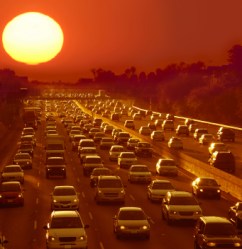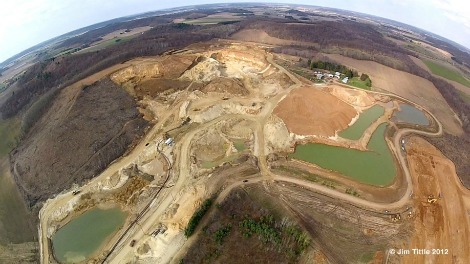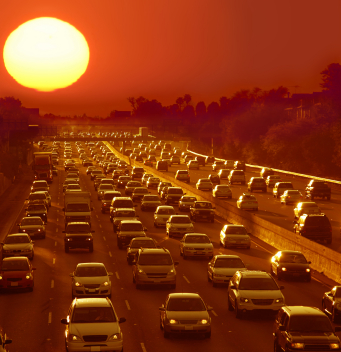
Is it me, or is it getting hot in here?
Two summers ago, the National Weather Service’s thermometer in downtown Los Angeles cracked 113 degrees F for the first time ever. Then it broke, leaving weather geeks to wonder if the city’s record high was actually even hotter than their tools were able to handle.
Better fix the thermometer, L.A. There’s more record heat on the way. A new study conducted by researchers at UCLA finds that climate change will drive up average temperatures in the City of Angels by an average of 4 to 5 degrees F by midcentury. And that’s just an average — some days, global warming will no doubt push the mercury even higher.
Another new report, from the National Research Council, predicts that sea level will rise up to a foot along the California coast in 20 years, and could top 5 feet by the end of the century. Again, these are averages. When the big storms roll in, folks in Malibu can kiss their beachfront mansions goodbye.
Los Angeles is one of many cities around the country that have been moving aggressively to reduce their contributions to climate change. Since his election in 2005, Mayor Antonio Villaraigosa has instated a massive climate action plan, retrofitting street lights with energy-efficient LEDs, enacting some of the nation’s strictest green building standards, and starting work on an ambitious mass transit expansion in a city that is famously enamored of the automobile.
And now, as national and international governments dick around, L.A. is among a group of cities that are bracing for the inevitable.
“There’s been a lack of progress at international negotiations. We saw it at Rio+20 [the Earth Summit last month in Rio de Janeiro, Brazil],” says Cynthia Rosenzweig, head of Climate Impacts Group at the NASA Goddard Institute for Space Studies in New York City. “There’s a growing realization that cities are the right level of governance to tackle climate change issues.”
Rosenzweig, who has been involved in the Intergovernmental Panel on Climate Change (IPCC) since it produced its first global assessment report in 1990, is among the leaders of the Urban Climate Change Research Network, a group of scientists working to chart a course for cities worldwide.
Last year, the network released its first IPCC-style climate report for cities. The report finds that urban areas are vulnerable to climate hazards and extremes such as heat waves and flooding, which can wreak havoc on energy systems, water supplies, and transportation systems. Extreme weather can also bring a slew of public health problems, including water- and foodborne diseases, the expanding range of vector-born diseases such as malaria and dengue, and respiratory illnesses brought on by worsening air quality. A second report, due out in 2015, will serve as a toolkit for cities that will be on the front lines of climate change.
Rosenzweig says cities are best equipped to handle these issues because they have a long history of responding to environmental issues and disasters (witness Hurricane Katrina, or, less disastrously, Irene, which nonetheless spurred the evacuation of 370,000 people from New York City), because city leaders are, by necessity, practical and action-oriented (“Mayors are the great pragmatists of the world’s stage,” New York Mayor Michael Bloomberg is fond of saying), and because cities are, quite literally, where the rubber hits the hot asphalt.
So while national and international leaders dicker with the details of inadequate agreements, cities are getting down to business. The C40 Cities Climate Leadership Group estimates that the leaders of the world’s metropolises have already taken more than 5,000 actions to mitigate climate change, resulting in a reduction of more than a billion tons of CO2 by 2030. In Rio, C40, Local Governments for Sustainability (a.k.a. ICLEI), and other groups announced a new initiative [PDF] to make cities more resilient to climate change.
“It’s not just about the polar bears anymore,” said an L.A. Times editorial following the release of the reports a few weeks ago.
The UCLA report, commissioned by the city, helps drive that message home by providing temperature predictions on a neighborhood scale. So residents of mountain and desert areas such as Palm Springs will cook an average of 4 to 5 degrees F hotter, for example, while beachside residents will see temperatures rise an average of just 3-4 degrees F. Small comfort, of course, given the waves that will soon be swamping the first floor, but it brings climate change into focus on a very real, very local level.
The report suggests a number of strategies for making Los Angeles more disaster-proof. It suggests creating more cooling centers to fend off heatstroke and other illness, encouraging energy conservation on hot days, and promoting water conservation. To ease the heat, it suggests adjusting building codes to allow more green and “cool” roofs and cool pavement, planting trees, and creating new parks.
Other cities, including New York, Chicago, and San Francisco, are taking similar measures.
Last month, at an Earth Summit side event sponsored by C40, Rosenzweig predicted that 20 years hence, the cities will throw the main event, while national governments host sideshows. The truth of the matter was that the international negotiations in Rio this year were already the sideshow. The real action was outside the official meeting halls, and much of it was being driven by cities.
As they say in Wisconsin, it’s hotter than Dutch love in harvest out there. And it’s going to get worse. A few mayors, at least, intend to be ready for it.




